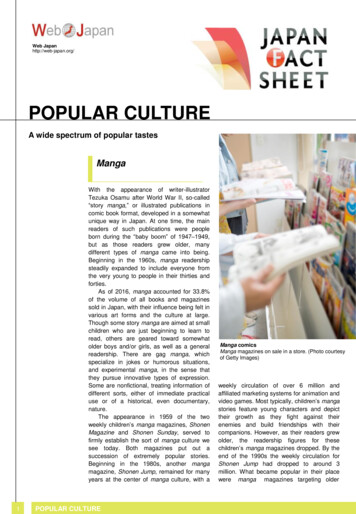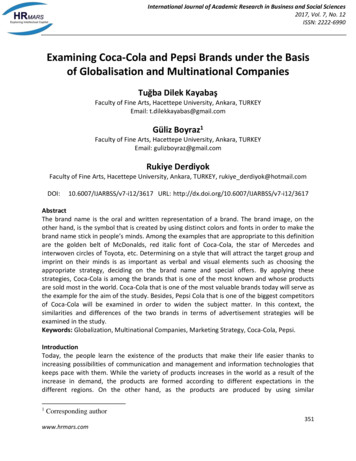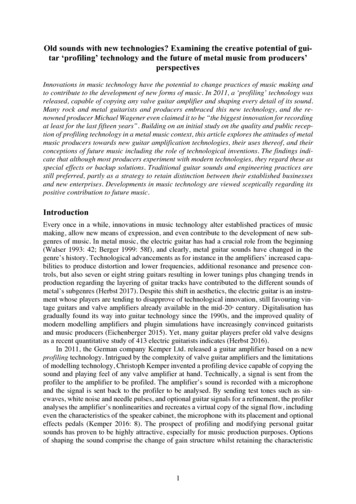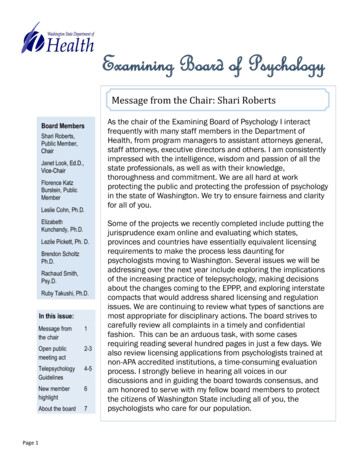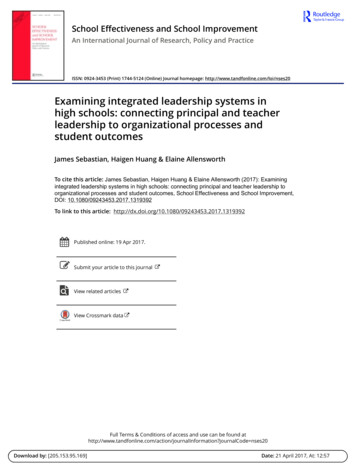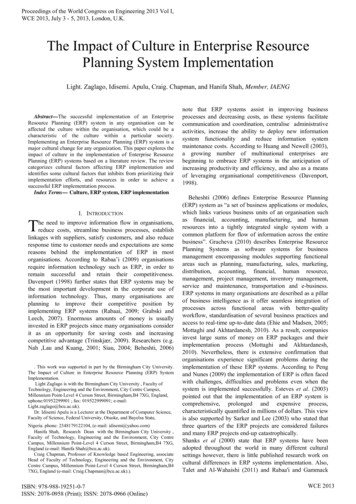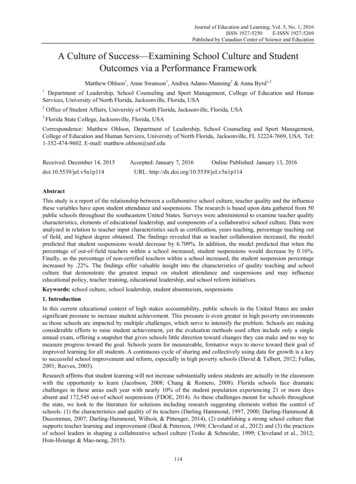
Transcription
Journal of Education and Learning; Vol. 5, No. 1; 2016E-ISSN 1927-5269ISSN 1927-5250Published by Canadian Center of Science and EducationA Culture of Success—Examining School Culture and StudentOutcomes via a Performance FrameworkMatthew Ohlson1, Anne Swanson1, Andrea Adams-Manning2 & Anna Byrd1,31Department of Leadership, School Counseling and Sport Management, College of Education and HumanServices, University of North Florida, Jacksonville, Florida, USA2Office of Student Affairs, University of North Florida, Jacksonville, Florida, USA3Florida State College, Jacksonville, Florida, USACorrespondence: Matthew Ohlson, Department of Leadership, School Counseling and Sport Management,College of Education and Human Services, University of North Florida, Jacksonville, FL 32224-7669, USA. Tel:1-352-474-9602. E-mail: matthew.ohlson@unf.eduReceived: December 14, 2015doi:10.5539/jel.v5n1p114Accepted: January 7, 2016Online Published: January 13, 2016URL: http://dx.doi.org/10.5539/jel.v5n1p114AbstractThis study is a report of the relationship between a collaborative school culture, teacher quality and the influencethese variables have upon student attendance and suspensions. The research is based upon data gathered from 50public schools throughout the southeastern United States. Surveys were administered to examine teacher qualitycharacteristics, elements of educational leadership, and components of a collaborative school culture. Data wereanalyzed in relation to teacher input characteristics such as certification, years teaching, percentage teaching outof field, and highest degree obtained. The findings revealed that as teacher collaboration increased, the modelpredicted that student suspensions would decrease by 6.709%. In addition, the model predicted that when thepercentage of out-of-field teachers within a school increased, student suspensions would decrease by 0.16%.Finally, as the percentage of non-certified teachers within a school increased, the student suspension percentageincreased by .22%. The findings offer valuable insight into the characteristics of quality teaching and schoolculture that demonstrate the greatest impact on student attendance and suspensions and may influenceeducational policy, teacher training, educational leadership, and school reform initiatives.Keywords: school culture, school leadership, student absenteeism, suspensions1. IntroductionIn this current educational context of high stakes accountability, public schools in the United States are undersignificant pressure to increase student achievement. This pressure is even greater in high poverty environmentsas those schools are impacted by multiple challenges, which serve to intensify the problem. Schools are makingconsiderable efforts to raise student achievement, yet the evaluation methods used often include only a singleannual exam, offering a snapshot that gives schools little direction toward changes they can make and no way tomeasure progress toward the goal. Schools yearn for measureable, formative ways to move toward their goal ofimproved learning for all students. A continuous cycle of sharing and collectively using data for growth is a keyto successful school improvement and reform, especially in high poverty schools (David & Talbert, 2012; Fullan,2001; Reeves, 2003).Research affirms that student learning will not increase substantially unless students are actually in the classroomwith the opportunity to learn (Jacobson, 2008; Chang & Romero, 2008). Florida schools face dramaticchallenges in these areas each year with nearly 10% of the student population experiencing 21 or more daysabsent and 172,545 out-of school suspensions (FDOE, 2014). As these challenges mount for schools throughoutthe state, we look to the literature for solutions including research suggesting elements within the control ofschools: (1) the characteristics and quality of its teachers (Darling Hammond, 1997, 2000; Darling-Hammond &Ducommun, 2007; Darling-Hammond, Wilhoit, & Pittenger, 2014), (2) establishing a strong school culture thatsupports teacher learning and improvement (Deal & Peterson, 1998; Cleveland et al., 2012) and (3) the practicesof school leaders in shaping a collaborative school culture (Teske & Schneider, 1999; Cleveland et al., 2012;Hsin-Hsiange & Mao-neng, 2015).114
www.ccsenet.org/jelJournal of Education and LearningVol. 5, No. 1; 2016Rather than focus directly on standardized test scores, this study focuses on two distinct variables which havebeen found to influence student achievement as well as student efficacy and graduation rates (Sheldon, 2003):attendance rates and out-of-school suspensions. Fifty high poverty schools in various districts throughout thestate of Florida were studied to determine the relationship among student outcomes (student attendance andstudent suspensions) and measurable teacher quality characteristics, the components of a collaborative of schoolculture, and the practices of school leaders in relation to school culture.The purpose of the study was to determine if teacher quality characteristics and school culture components arerelated to student attendance and suspension rates. The methods chosen for this study provide insight into theimpact school culture and the characteristics of effective teaching may have upon student outcomes.2. Review of the Literature2.1 Teacher Quality CharacteristicsThe quality of a teacher can have a direct and lasting impact on student achievement (Ingersoll, 2003; Rice, 2003;Wright, Horn, & Sanders, 1997; Darling-Hammond & Ducommun, 2007). A quality teacher can negate theeffects of a student’s socio-economic status and lead to increased student outcomes (Darling-Hammond, 1997;Porter-Magee, 2004). Additionally, no adults are more important to student success than teachers(Cochran-Smith & Fries, 2005a; Haycock, 2001; Wechsler, Tiffany-Morales, Campbell, Humphrey, Kim, &Shields, 2007). The importance of teacher quality is further exemplified by research that determined teacherexpertise and certification are better predictors of student success than class size, teacher salaries, andper-student spending (Darling-Hammond, 1997). Thus, it is imperative to determine what constitutes qualityteaching and adapt policies that ensure that quality teachers are trained, recruited, and retained to meet thelearning goals of students.Defining “quality” teaching and quantifying teacher quality characteristics is complicated and highly contested(Walsh, 2007; Darling-Hammond & Ducommun, 2007). However, educational researchers have studiedindicators of teacher quality found to promote positive student outcomes. For policy makers to providecomprehensive teacher evaluation programs, it is paramount to understand what constitutes quality teaching.Linda Darling-Hammond (2000) found that student achievement increased and dropout rates decreased whenteachers were certified in their field, obtained their master’s degrees, and were enrolled in graduate studies. Inaddition, she contends that teacher preparation and certification had the strongest correlation for studentachievement, more than any other school based factors. Furthermore, teaching in field, in math and scienceparticularly, led to increased student achievement (Goldhaber & Brewer, 1997).Specifically, the quality of a teacher may have a direct and lasting influence upon student outcomes (Ingersoll,2003; Rice, 2003; Wright, Horn, & Sanders, 1997; Hsin-Hsiange & Mao-neng, 2015). Furthermore, teacherquality is a better predictor of student success than class size, teacher salaries, and per-student spending(Darling-Hammond, 1996). A quality teacher can negate the effects of a student’s socio-economic status andlead to increased student outcomes (Darling-Hammond, 1996; Porter-Magee, 2004).There are numerous teacher quality factors that have been proven to significantly influence student achievementand student outcomes. Higher Scholastic Aptitude Test (SAT) scores and higher grades for teachers in college(Gitomer, 2007) as well as high level of general intelligence, content knowledge and knowledge of pedagogicaltechniques including scaffolding and ability to adapt to diverse learners (Darling-Hammond & Ducommun, 2007)resulted in higher student outcomes. Specifically in poor schools, student achievement has shown to be improvedwhen schools employ strategies to improve teacher qualifications, such as hiring teachers with higher LiberalArts and Sciences Teacher (LAST) certification exam scores (Boyd, Lankford, Loeb, Rockoff, & Wychoff,2008). Further research affirms the importance of educator experience suggesting that years teaching shows avery strong relationship with increased student achievement (Darling-Hammond, Berry, & Thoreson, 2001;Greenwald, Hedges, & Laine, 1996).2.2 School Leadership & Collaborative CultureIn addition to quality teachers, school leadership plays a paramount role in influencing teacher-workingconditions. Effective instructional leadership is generally recognized as the most important characteristic ofschool administrators (Hoy & Hoy, 2009). Cosner and Peterson (2003) go so far as to claim that promotingteacher professional development is the most influential educational leadership behavior. Principals andadministrators are needed to lead educational improvement, foster effective change efforts, lead theimplementation of new standards, and are central to shaping strong, professional school cultures (Deal &Peterson, 1998).115
www.ccsenet.org/jelJournal of Education and LearningVol. 5, No. 1; 2016Fullan (2001) suggests that school leaders participate in activities that encourage teacher learning. Theseactivities may include leading educational improvement, fostering effective change efforts, and directing theimplementation of new standards, which are central to shaping strong, professional school cultures (Deal &Peterson, 1998; Webb & Norton, 2013). In addition, educational leaders should establish a partnership withteachers to work towards the primary goal of improving teaching and learning (Hoy & Hoy, 2009). Theimportance of educational leadership as it relates to teacher quality and supervision is further supported by theassertion that good teaching is the ultimate goal of educational leadership and the policies and actions ofeducational leaders should foster ways to improve teaching and learning (Hoy & Hoy, 2008). Thus,administrators at all levels must become knowledgeable not only of the effective techniques of teacherevaluation, but more importantly of the research-based educational strategies that have been successful atimproving teacher efficacy and student learning (Goddard & Goddard, 2001; VonVillas, 2004; Webb & Norton,2013).The relationship between effective teaching and effective leadership is reinforced in the vital role of schoolculture (Hsin-Hsiange & Mao-neng, 2015). Among the numerous definitions of school culture, Deal andPeterson (1990) and Schein (1985) affirm that school culture refers to the deep patterns of values, beliefs andtraditions that have been formed over the course of the school's history and which are understood by members ofthe school community. Peterson (2002) suggests that culture is built within a school over time as teachers, schoolleaders, parents and students work together. It is the school culture that often influences the staff developmentand professional growth that takes place within a school. Fullan and Steiglebauer (1991) and Boonstra (2013)contend that the key to successful change is not only a change in organizational structure but also moreimportantly a change in the culture. A positive school culture may have a significant influence on the academicand social success of the students within schools (Squires & Kranyik, 1996). When a school exhibitscharacteristics of a positive school culture, there are fewer suspensions, increased attendance rates, and increasedachievement on standardized test scores (Anson et al., 1991; Becker & Hedges, 1992).The culture within a school also influences student achievement (Levin, 2004). Deal and Peterson (1998),contend that higher achieving schools were those that demonstrated cultures that fostered collaboration,empowerment, and engagement. In contrast, schools with toxic cultures with little stakeholder collaborationwere more likely to produce poor academic achievement. Leithwood and Seashore-Louis (1998) suggest thatsuccessful schools are more capable of increasing student achievement when the culture shares commoncharacteristics including a commitment to the students, respect for shared decision making, a collective belief inthe importance of professional growth, collective celebrations of success, and a mission grounded in the idealthat all students can achieve.2.3 Absences & ParticipationAmongst student outcomes, student attendance and student suspension rates are important factors in measuringthe academic success of students. Researchers have established significant correlations between studentattendance in the classroom and academic achievement (Seldon, 2003; Morrissey, Hutchison, & Winsler, 2014).Students with better attendance than their classmates exhibit superior performance on standardized achievementtests and are more likely to be retained (Barth, 1984; Nichols, 2003). Also, high rates of student absenteeism areassociated with increased risk of students dropping out of school (McCluckie, 2014) and the increased likelihoodof delinquent behaviors such as violence and alcohol/drug usage (Baker, 2000; Rumberger & Thomas, 2000).Such behaviors are often addressed using discipline such as out-of-school suspension. However, researchsuggests that the utilization of out-of-school suspensions may increase the likelihood of absenteeism (Baker,2000; Bell, Rosen, & Dynlacht, 1994). Both traditional absenteeism (by choice of the student or family) and outof school suspensions end in the same result-the student is out of class and therefore is at a serious disadvantageacademically (Baker, 2000). Understanding the significance of these student outcomes (student attendance andout-of school suspensions) is paramount to the significance of the study.Furthermore, a recent study of school-level attendance rates showed a significant relationship betweenschool-level Socio-Economic Status (SES) and school-level annual daily attendance (Reardon, 2008). Thisrelationship between attendance and student achievement is even more pronounced when examining at-risk andminority students (Morrissey, Hutchison, & Winsler, 2014). Ali and Dufresne (2008) contend that children whoare most likely to be excluded from school are the ones who are least able to afford to fall behind. A Minnesotastudy of public school student achievement and attendance data found that boosting student attendance by aslittle as one percent could significantly increase test scores of minority students (Roby, 2004). A recent study byReardon (2008) examining the relationship between school-level socio-economic status and school-level annual116
www.ccsenet.org/jelJournal of Education and LearningVol. 5, No. 1; 2016daily attendance, demonstrated that the highest poverty schools exhibited the highest excessive absence rates.Thus, minority and high poverty students may have the most to gain with increased attendance.Out-of-school student suspensions can also have wide-ranging, detrimental effects on both the individual and theschool community including increased student dropout rates, homelessness and crime (Arthur, Hawkins, Pollard,Catalano, & Baglioni, 2002; Mendez, Knoff, & Ferron, 2002). Ali and Dufresne (2008) report that suspensionsmay increase the likelihood of involvement in the juvenile justice system, as children and youth who are senthome from school often remain unsupervised when their parents work. Students who are suspended are also lesslikely to graduate from high school as they seek to avoid the setting where castigation and punishment is beingadministered (Railsback, 2004). Baker, Sigmon, and Nugent (2001) further contend that adults who werefrequently absent or suspended as teenagers are much more likely than those who were not to have inferiorphysical and mental health, lower paying jobs, an increased chance of living in poverty, and more reliance onwelfare support.Student suspension data has also created much controversy in the demographics of the students being suspended.A disproportional number of minority students, male students, and special education students receiveout-of-school suspensions (Constenbader & Markson, 1998; Skiba & Peterson, 1999; Wu, Pink, Crain, & Moles,1982; U.S. Department of Education Office for Civil Rights, 2014). A study of middle school studentpunishment practices by Skiba, Michael, Nardo and Peterson (2002) exposed a differential pattern of treatment,originating at the classroom level, wherein African-American students are referred to the office for infractionsthat are more subjective in interpretation. A study by Bowman (2003) of the suspension practices of schools inKentucky found that African American students are suspended from school two to 17 times as often as whites insome districts. These issues further highlight the significance student suspensions and the reduction thereof canplay upon school success and student achievement.3. Conceptual FrameworkThe conceptual basis for the research is grounded in the educational performance framework (Goldhaber &Brewer, 1997; Levin, 2004). A performance framework (Figure 1) may be conceptualized as having three mainparts: inputs, processes, and outputs (Rouse & Putterill, 2003).Figure 1. Performance framework (Rouse and Putterill, 2003)For the purpose of this research, inputs apply to the characteristics the individual brings to the workplace. The“inputs” construct was operationalized by four variables reported in the Florida School Indicators Report (2008):a measure of the percentage of classes taught by out-of-field teachers, the percentage of teachers with advanceddegrees, teacher certification rates and the average years of experience for teachers within a school.Processes refer to pedagogical development and practice in and outside of the classroom including the elementsanalyzed with the School Culture Survey. “Processes” refer to pedagogical development and practice in andoutside of the classroom. Examples include the nature of collaboration with peers, administrator evaluations, andprofessional development activities. Aggregated at the school level, these variables form the heart of educationalleadership (Leithwood, Jantzi, & Dart, 1990). The “process” construct was operationalized by variables obtainedfrom Gruenert and Valentine’s (1998) School Culture Survey.117
www.ccsenet.org/jelJournal of Education and LearningVol. 5, No. 1; 2016Outputs are the immediate and recurring indicators of students within a school and include attendance rates andsuspension rates. The “outputs” construct was operationalized by both student absences and suspensions asreported by the annual Florida Department of Education’s Florida School Indicators Report. Specifically, studentabsence data reflected the percentage of a school’s population that was absent 21 or more days. Suspension datareflected the percentage of a school’s population suspended outside of school during the 180-day academicschool year. This percentage utilized an unduplicated-headcount to ensure the same student was not countedtwice.Specifically, the performance framework data were examined to address the following research questions:1) Is there an effect of school culture factors, as perceived by teachers, and characteristics of teacher quality onstudent attendance?2) Is there an effect of school culture factors, as perceived by teachers, and characteristics of teacher quality onstudent suspension rates?4. MethodologyAs a quantitative study, the research utilized a statistical survey and statistical modeling perspective. Theresearch methods utilized to collect data included the use of surveys, student outcome data, and teach and schooldemographic data. Data were obtained from 50 schools in Florida representing significant diversity in terms ofdemographics, locations and school size.4.1 ParticipantsParticipants of this study were instructional faculty employed by 50 schools located in Florida. The total numberof teachers participated was 1657 and the average response rate within each school was 66%. The demographicbreakdown of the sample is discussed further. 71 % of respondents identified as female and 29 % as male.51 % were white (non-Hispanic), 18 % African-American/Black, 3 % Asian/Pacific Islanders, and alittle less than 28 % as Hispanic/Latino, American-Indian, or Multiracial.4.2 Data CollectionTo evaluate the culture within each school, the School Culture Survey (Gruenert & Valentine, 1998) was utilized(Appendix A). The data were collected at each school site via electronic distribution. Teachers were asked tocomplete the survey through an email link distributed by the school administration. Survey responses wereanonymous and data were collected from all sites using an online survey tool. Participants were allowed oneweek to complete the survey and all responses were collected and analyzed within ten days.4.3 InstrumentationThe School Culture Survey (Gruenert & Valentine, 1998) was the instrument for this study. It was employed togauge the faculty of their individual perceptions of the school and organizational culture. The School CultureSurvey evaluates the perceptions of school faculty (teachers, administrators, etc.) in relation to six unique factorsrelated to school culture by asking participants to rate its 35 items on a 5-point Likert-type scale with 1 being“strongly disagree” and 5 being “strongly agree”. The six factors include professional development, the unity ofpurpose, collaborative leadership, teacher collaboration, collegial support, and learning partnership. The 35 itemsof the survey delineated each individual’s school culture. The parts of the instrument measuring each of the sixfactors have been established as reliable. Cronbach’s alpha was calculated to assure reliability as suggested byMuijs (2011). Cronbach’s alpha values were .910, .834, .821, .867, .796 for Collaborative Leadership factor;Teacher Collaboration factor, Professional Development factor, Collegial Support factor, Unity of purpose factorand the Learning Partnership factor respectfully.The data from the School Culture Survey are essential to evaluate the current school culture as perceived by thefaculty and to establish goals related to the specific needs revealed in the analysis. This instrument also affordsthe school community the opportunity to examine which elements of school culture may be directly impactingstudent achievement and teacher working conditions. For this particular research, the culture survey serves toexamine the processes at the school level and their role influencing student outputs or outcomes.With this, the independent variables for this study were six factors of school culture described above as well ascharacteristics of teacher quality (the percentage of classes taught by out-of-field teachers, the percentage ofteachers with advanced degrees, teacher certification rates and the average years of experience for teacherswithin a school) while the dependent variables were student suspension rate and student attendance rate.118
www.ccsenet.org/jelJournal of Education and LearningVol. 5, No. 1; 20164.4 Data AnalysisData were analyzed using correlational analysis, multiple linear regression and descriptive statistics. Analysiswas performed using SPSS software package. First, correlational and multiple linear regression analysis wereperformed with the dependent variable as excessive student absences, quantified by 21 or more days absenteepercentage within each school. The data was first checked for outliers; none were detected, thereby the samplesize was maintained at 50 schools. Descriptive statistics were examined to determine the mean and standarddeviation.Then, to examine the relationships and predictive associations of the independent variables upon the secondstudent outcome, correlational and regression analysis were performed with the dependent variable asout-of-school suspension percentage within a school. Descriptive statistics indicate the dispersion of scores andpercentages for the dependent and independent variables. Pearson correlations were then used to determine therelationships between the independent variables with the student suspension percentages within a school as thedependent variables.5. Results5.1 Question 1: Student AttendanceThe first research question asked if there were statistically significant predictive effect of school culture factors,as measured by the School Culture Survey (collaborative leadership, teacher collaboration, professionaldevelopment, collegial support, unity of purpose and learning partnership), and the characteristics of teacherquality (the percentage of classes taught by out-of-field teachers, the percentage of teachers with advanceddegrees, teacher certification rates and the average years of experience for teachers within a school) on studentattendance.Pearson correlations between students with 21 or more absences and the independent variables were utilized todemonstrate the relationships between the variables (The model summary determined the R (.564), the R square(.319), adjusted R square (.144), and the standard error of the estimate (4.156) with excessive absence percentageas the dependent variable. The analysis of variance revealed an F value of 1.823 with significance at .089indicating that there were no significant predictive relationships between the dependent and independentvariables.5.2 Question 2: School SuspensionsThe second research question asked if there were statistically significant predictive effect of school culturefactors, as measured by the School Culture Survey (collaborative leadership, teacher collaboration, professionaldevelopment, collegial support, unity of purpose and learning partnership), and the characteristics of teacherquality (the percentage of classes taught by out-of-field teachers, the percentage of teachers with advanceddegrees, teacher certification rates and the average years of experience for teachers within a school) on schoolsuspensions.The model summary determined the R (.786), the R square (.618), the adjusted R square (.520), and the standarderror of the estimate (2.558). The analysis of variance displays the F of 6.311 with significance .001. Multiplelinear regression showed significant relationships between percentage of out-of-school suspensions and some ofthe independents variables. The variables that showed significance at this level were teacher collaboration(p .041), out-of-field percentage (p .001), and teachers without certification percentages (p .001). These resultsdemonstrate that of those variables that are significant, there are predictive associations between the independentand dependent variables. For example, for each one-point increase in the teacher collaboration factor from theschool culture survey, the model predicated that school suspensions were observed to decrease by 6.709%.Furthermore, as the percentage of out-of-field teachers within a school increased by one percentage point, themodel predicted that the percentage of students suspended out-of-school would decrease by 0.162%. Conversely,as the percentage of uncertified teachers within a school increased by one percentage point, the model predictedthat the percentage of student suspensions would increase by .222%.6. DiscussionPearson correlations were utilized to indicate the strength of the linear relationship between and within theindependent and dependent variables. The Pearson correlation data (Table 2) revealed no significant correlationbetween the first dependent variable (excessive absences) and the teacher quality characteristics and a significantnegative correlational relationship between all school culture factors except for Teacher Collaboration. Pearsoncorrelations were used for the second model with suspension percentages as the dependent variable, and showed119
www.ccsenet.org/jelJournal of Education and LearningVol. 5, No. 1; 2016a positive correlation with all independent variables other than the years of teaching experience (not significant)and teachers without certification (.624, positive correlation). This data further demonstrated numeroussignificant correlations between teacher quality characteristics and school culture factors.The performance framework model, using multiple regressions and correlations, predicted no significantassociations between school culture, as perceived by teachers, teacher qualities and student absences. Thestudent suspension outcome variable showed significant relations of three independent variables (teachercollaboration, out-of-field teacher percentage and teacher certification) and the number of out-of-schoolsuspensions. The model predicted that as the teacher collaboration factor within the school culture surveyincreased, student suspensions would decrease by 6.709%. In addition, the model predicted that with eachone-point incremental increase for the percentage of out-of-field teachers within a school, the observed numberof suspensions would decrease by .162%. Then, as the percentage of non-certified teachers within a schoolincreased, the model predicted that student suspensions would increase by .222%.The first surprising detail emerging from the data was the fact that there were no correlational relationshipsbetween teacher quality characteristics and the excessive student absence variable. This calls into question thevalue of using that particular variable in determining student outcomes and ultimately, student achievement.Excessive absences, especially at the elementary level, may not be the most v
Keywords: school culture, school leadership, student absenteeism, suspensions 1. Introduction In this current educational context of high stakes accountability, public schools in the United States are under significant pressure to increase student achievement. T


